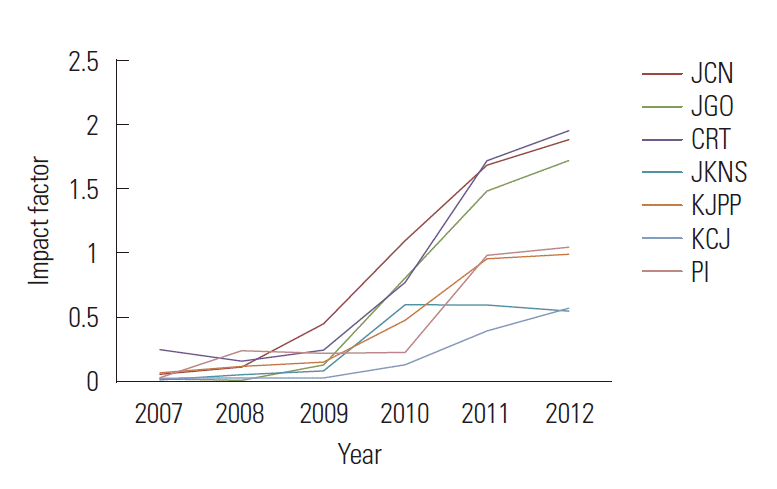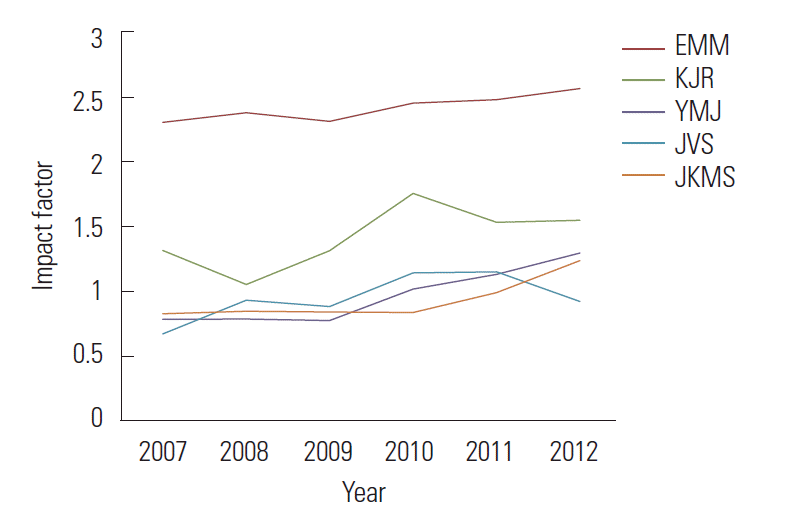Increase in frequency of citation by SCIE journals of non-Medline journals after listing in an open access full-text database
Article information
Abstract
We hypothesized that it is not open access status but rather exposure in the PubMed platform that affects citation frequency in medical journals. In November 2008, medical journals from Korea began to be added to PubMed Central (PMC). Therefore, it would be interesting to know whether or not their impact factor based on Web of Science has increased since the journals were listed in PMC/PubMed. To answer this question, a citation analysis of seven journals that have been indexed in PMC since 2008 or 2009 was done. Only non-Medline journals were selected and the impact factors of five Medline journals were compared. The impact factor was calculated via Web of Science. Journal Citation Reports (JCR) data were used if the data of the target journals were provided in JCR. Trends for the impact factors of different years were analyzed using dBSTAT ver. 5.0. There has been an increasing rates of the impact factor for the seven non-Medline journals, 1.92 in 2011 over 2010 ; 3.27 in 2010 over 2009 ; 1.12 in 2012 over 2011. As for the five Medline journals, the increasing rate in 2010 over 2009 was 1.18 ; however, those of 2011 over 2010 and 2012 over 2011 were 1.01 and 1.04 respectively. The Science Citation Index Expanded impact factor of medical journals published in Korea can be increased if those journals are published in English and listed in PMC. This is an effect of the platform in which the journals are listed and not just an effect of free access.
Introduction
In order to recruit high quality manuscripts, journal editors aim to increase the impact factor of their journals. Even though all 227 medical journals from the Republic of Korea provide open access or free access, their impact factors have not increased for a long time. It is postulated that this phenomenon stems from the lack of a platform by which they can be exposed to medical researchers throughout the world. PubMed, the database run by the United States National Library of Medicine (US NLM) that is freely accessible to anyone on the internet, is the most important such platform in biomedical fields. Most journals are indexed in PubMed when they are selected by a panel, the Literature Selection Technical Review Committee of the US NLM, for inclusion in the Medline database. However, another way to gain inclusion in PubMed is by offering the full-text of a journal for indexing in PubMed Central (PMC). From 2004 to 2013, most medical journals from Korea have failed to gain inclusion in PubMed through the first option-passing the Medline selection threshold. Exceptions include the Journal of Preventive Medicine and Public Health (2005) ; Annals of Laboratory Medicine (2007 ; previous title, Korean Journal of Laboratory Medicine); Journal of the Korean Academy of Nursing (2008); and Clinics in Orthopedic Surgery (2009). Therefore, editors of journals in Korea written in English that have not been indexed in the Medline database have decided to participate in PMC since 2008. Here, the results of the strategy of editors to increase their medical journal’s impact factor by participating in PMC is presented. A hypothesis is also tested: that it is not open access but PubMed listing that affects the citation frequency in the medical field.
Methods
To answer this question, a citation analysis of seven Englishlanguage journals of Korea was done. Seven out of the 18 journals first indexed in PMC in 2008 or 2009 were selected according to the following criteria: (1) not being included in Medline up to the present; (2) over 40 papers published annually ; (3) publication since 2005 or earlier. The two-year impact factor was calculated through Web of Science. Journal Citation Reports (JCR) data were used if the data of the target journals were provided in JCR. To compare the change in the impact factor of Medline journals with that of non-Medline journals, five Medline journals’ impact factors were also traced. Trends for the impact factors of different years were analyzed using dBSTAT ver. 5.0 (DBSTAT Co., Chuncheon, Korea) available from: http://dbstat.com.
Results
The increasing rates of the impact factor of the seven non- Medline PMC journals were 3.27 in 2010 (mean±SD, 0.585± 0.317) over 2009 (0.179±0.129); 1.92 in 2011 (1.123±0.487) over 2010; and 1.12 in 2012 (1.125±0.558) over 2011 (Fig. 1). The increasing rates of the impact factor of the five Medline journals were 1.18 in 2010 (1.445±0.593) over 2009 (1.223± 0.573); 1.01 in 2011 (1.462±0.540) over 2010 ; and 1.04 in 2012 (1.522±0.563) over 2011 (Fig. 2).

Chronological change in the impact factor of 7 non-Medline journals from Korea indexed in PubMed Central from 2007 to 2012. JCN, Journal of Clinical Neurology; JGO, Journal of Gynecologic Oncology; CRT, Cancer Research and Treatment; JKNS, Journal of the Korean Neurosurgical Society; KJPP, Korean Journal of Physiology and Pharmacology; KCJ, Korean Circulation Journal; PI, Psychiatry Investigation.

Chronological change in the impact factor of 5 MEDLINE journals from Korea indexed in PubMed Central from 2007 to 2012. EMM, Experimental and Molecular Medicine; KJR, Korean Journal of Radiology; YMJ, Yonsei Medical Journal; JVS, Journal of Veterinary Science; JKMS, Journal of Korean Medical Science.
Discussion
The remarkable increase in the impact factor of non-Medline journals from Korea from 2009 to 2011 may indicate that the competence of these journals was not properly reflected in the impact factor until they received worldwide exposure through the most important biomedical database, PubMed. Since most of the papers from those journals continue to be from Korean authors, which is almost the same pool of contributors from year to year, the change in the impact factor cannot be explained by sudden improvement of the quality of the papers themselves. A more satisfactory explanation is the increased chance of exposure to international readers via PMC/PubMed. There was not such a dramatic increase in the impact factor of Medline journals in 2010 over 2009. The change in the impact factor was negligible in 2011 over 2010 and 2012 over 2011. This reflects the fact that the Medline journals have already been well-exposed to the world and the competence of the journals is fully reflected in their impact factor. Therefore, once they have been included in PMC, there is a no further effect of exposure. The increase rate in the impact factor of the seven non-Medline journals in 2012 over 2011 was 1.12. It means that the exposure effect of those journals had already been reflected in the impact factor; once this occurred, the sharp increase in the impact factor slowed down.
There has been debate over the effect of an open access policy on the impact factor of a journal. Some studies have shown a positive effect from open access but others have found no such evidence. An analysis by Thomson Reuters, the organization that manages the Science Citation Index listings, showed that a consistent feature among the life sciences, medicine, chemistry, and physical sciences is that the mean rank of open access journals according to the immediacy index is higher than that according to the journal impact factor [1]. Using an instrumental variable approach for articles published in the second half of 2004 in Proceedings of the National Academy of Sciences, in which authors may choose to pay an extra fee to make their article open access, Gaule and Maystre [2] suggested that authors of higher quality papers were more likely to pay for open access. They found no evidence for a causal effect of open access on citations. Davis et al. [3] analyzed 11 journals published by the American Physiological Society. A total of 1,609 research articles and reviews were included. Fifty-nine percent of the open access articles (146 of 247) were cited nine to 12 months after publication compared with 63% (859 of 1,372) of the subscription access articles. Logistic and negative binomial regression analysis of article citation counts confirmed no citation advantage for the open access articles. However, analyzing the ISI’s JCR for 2002 in the fields of philosophy, political science, electrical and electronic engineering, and mathematics, Craig et al. [4] found that across all four disciplines, freely available articles do have a greater research impact.
Nevertheless, previous debates on the effect of open access on the impact factor have not focused on the exposure platform of the journal. The present study provides a clue about the importance of having a platform of exposure to researchers. It has also demonstrated the impact and power of PubMed among the medical literature databases, even though Google Scholar has become the primary search site for scientists nowadays. Most medical editors in Korea have come to understand the effect of PMC/PubMed inclusion on the impact factor; therefore, they have begun to convert their journals from Korean-language to English-language publications, a requirement for inclusion. As of the end of October 2013, 74 medical journals from Korea were included in PMC. They are all published by academic societies or non-profit organizations. Thirteen more journals from Korea are to be included in PMC, and the number of PMC journals from Korea can be expected to continue to increase in the future.
In conclusion, it can be said that the best way for local medical journals, particularly those from Korea, to be cited by SCIE journals more frequently, is to publish journals in English and to add them to PMC. Further study is needed to determine whether this phenomenon also occurs for the non-Medline local medical journals of other countries indexed in PMC/PubMed.
Notes
No potential conflict of interest relevant to this article was reported.
Acknowledgements
This work was supported by a research grant of the National Research Foundation of Korea (policy research-2013-003-academic infrastructure promotion) and the Korean Federation of Science and Technology Societies (KOFST-2013), Government of the Republic of Korea.
